Deakin University: Business Case Analysis of Gap Inc. with Big Data
VerifiedAdded on 2021/05/31
|5
|1078
|29
Case Study
AI Summary
This business case examines Gap Inc.'s strategic shift towards leveraging big data and analytics to revitalize its brand and regain market share. Faced with declining sales and a changing consumer landscape, Gap Inc. under the leadership of CEO Art Peck, embraced a data-driven approach to understand customer buying behaviors, enhance customer experience, and improve IT alignment. The analysis highlights the company's efforts to integrate e-commerce, streamline operations, and foster a data-informed creative ecosystem. The case emphasizes the importance of aligning IT initiatives with business objectives to drive strategic relevance and improve overall business performance, particularly in the context of the highly variable and competitive clothing industry. Desklib provides access to this and many other solved assignments for students.
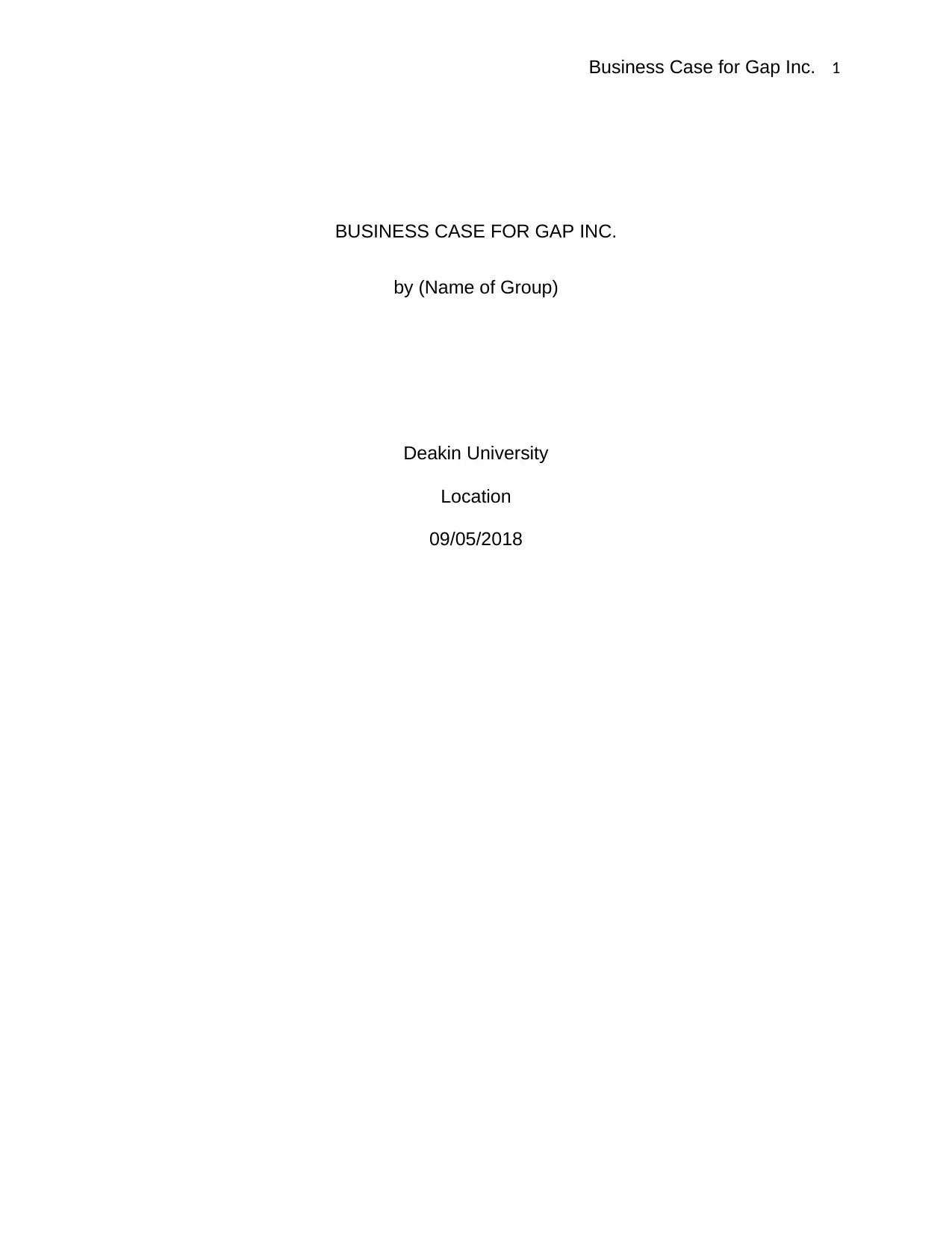
Business Case for Gap Inc. 1
BUSINESS CASE FOR GAP INC.
by (Name of Group)
Deakin University
Location
09/05/2018
BUSINESS CASE FOR GAP INC.
by (Name of Group)
Deakin University
Location
09/05/2018
Paraphrase This Document
Need a fresh take? Get an instant paraphrase of this document with our AI Paraphraser
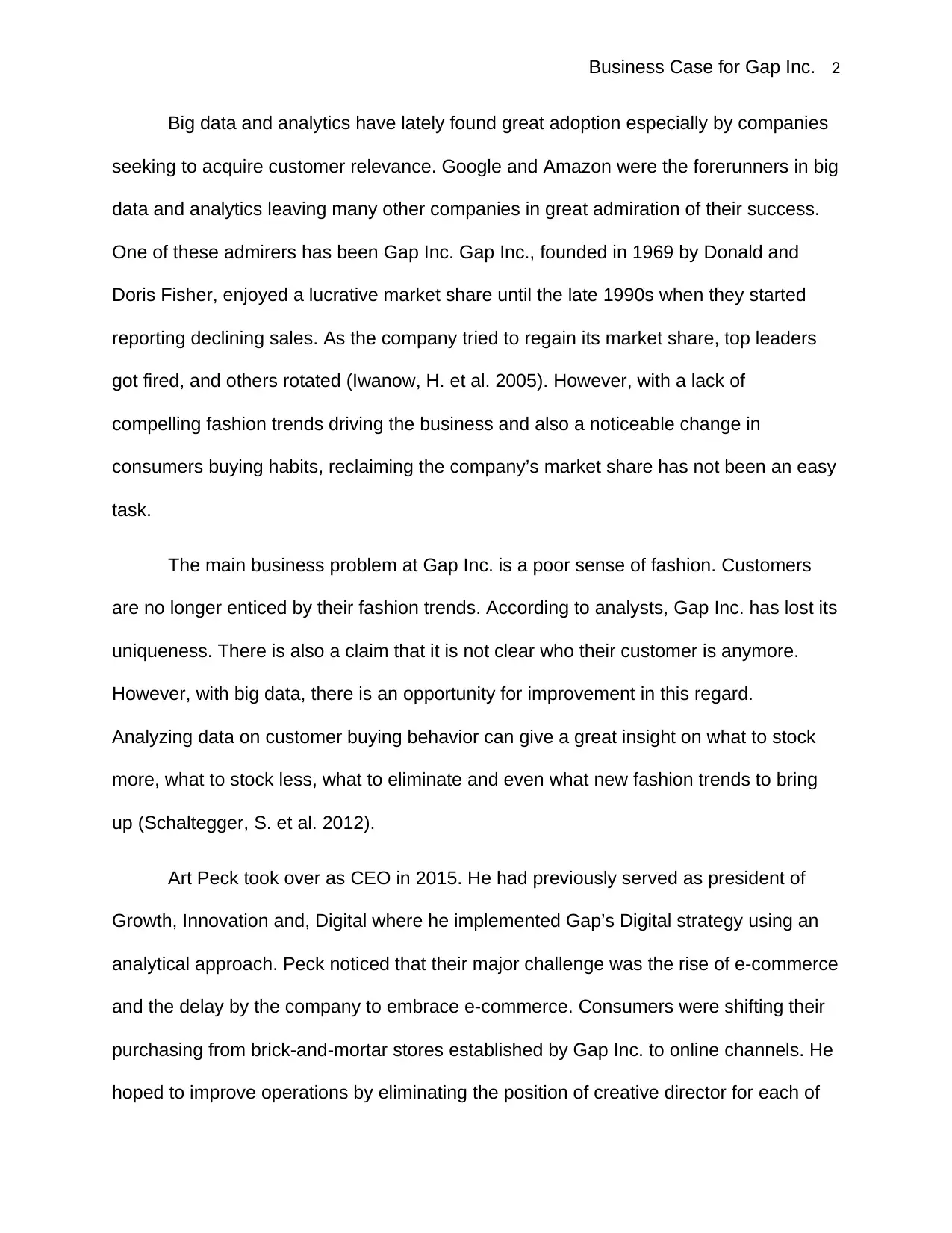
Business Case for Gap Inc. 2
Big data and analytics have lately found great adoption especially by companies
seeking to acquire customer relevance. Google and Amazon were the forerunners in big
data and analytics leaving many other companies in great admiration of their success.
One of these admirers has been Gap Inc. Gap Inc., founded in 1969 by Donald and
Doris Fisher, enjoyed a lucrative market share until the late 1990s when they started
reporting declining sales. As the company tried to regain its market share, top leaders
got fired, and others rotated (Iwanow, H. et al. 2005). However, with a lack of
compelling fashion trends driving the business and also a noticeable change in
consumers buying habits, reclaiming the company’s market share has not been an easy
task.
The main business problem at Gap Inc. is a poor sense of fashion. Customers
are no longer enticed by their fashion trends. According to analysts, Gap Inc. has lost its
uniqueness. There is also a claim that it is not clear who their customer is anymore.
However, with big data, there is an opportunity for improvement in this regard.
Analyzing data on customer buying behavior can give a great insight on what to stock
more, what to stock less, what to eliminate and even what new fashion trends to bring
up (Schaltegger, S. et al. 2012).
Art Peck took over as CEO in 2015. He had previously served as president of
Growth, Innovation and, Digital where he implemented Gap’s Digital strategy using an
analytical approach. Peck noticed that their major challenge was the rise of e-commerce
and the delay by the company to embrace e-commerce. Consumers were shifting their
purchasing from brick-and-mortar stores established by Gap Inc. to online channels. He
hoped to improve operations by eliminating the position of creative director for each of
Big data and analytics have lately found great adoption especially by companies
seeking to acquire customer relevance. Google and Amazon were the forerunners in big
data and analytics leaving many other companies in great admiration of their success.
One of these admirers has been Gap Inc. Gap Inc., founded in 1969 by Donald and
Doris Fisher, enjoyed a lucrative market share until the late 1990s when they started
reporting declining sales. As the company tried to regain its market share, top leaders
got fired, and others rotated (Iwanow, H. et al. 2005). However, with a lack of
compelling fashion trends driving the business and also a noticeable change in
consumers buying habits, reclaiming the company’s market share has not been an easy
task.
The main business problem at Gap Inc. is a poor sense of fashion. Customers
are no longer enticed by their fashion trends. According to analysts, Gap Inc. has lost its
uniqueness. There is also a claim that it is not clear who their customer is anymore.
However, with big data, there is an opportunity for improvement in this regard.
Analyzing data on customer buying behavior can give a great insight on what to stock
more, what to stock less, what to eliminate and even what new fashion trends to bring
up (Schaltegger, S. et al. 2012).
Art Peck took over as CEO in 2015. He had previously served as president of
Growth, Innovation and, Digital where he implemented Gap’s Digital strategy using an
analytical approach. Peck noticed that their major challenge was the rise of e-commerce
and the delay by the company to embrace e-commerce. Consumers were shifting their
purchasing from brick-and-mortar stores established by Gap Inc. to online channels. He
hoped to improve operations by eliminating the position of creative director for each of
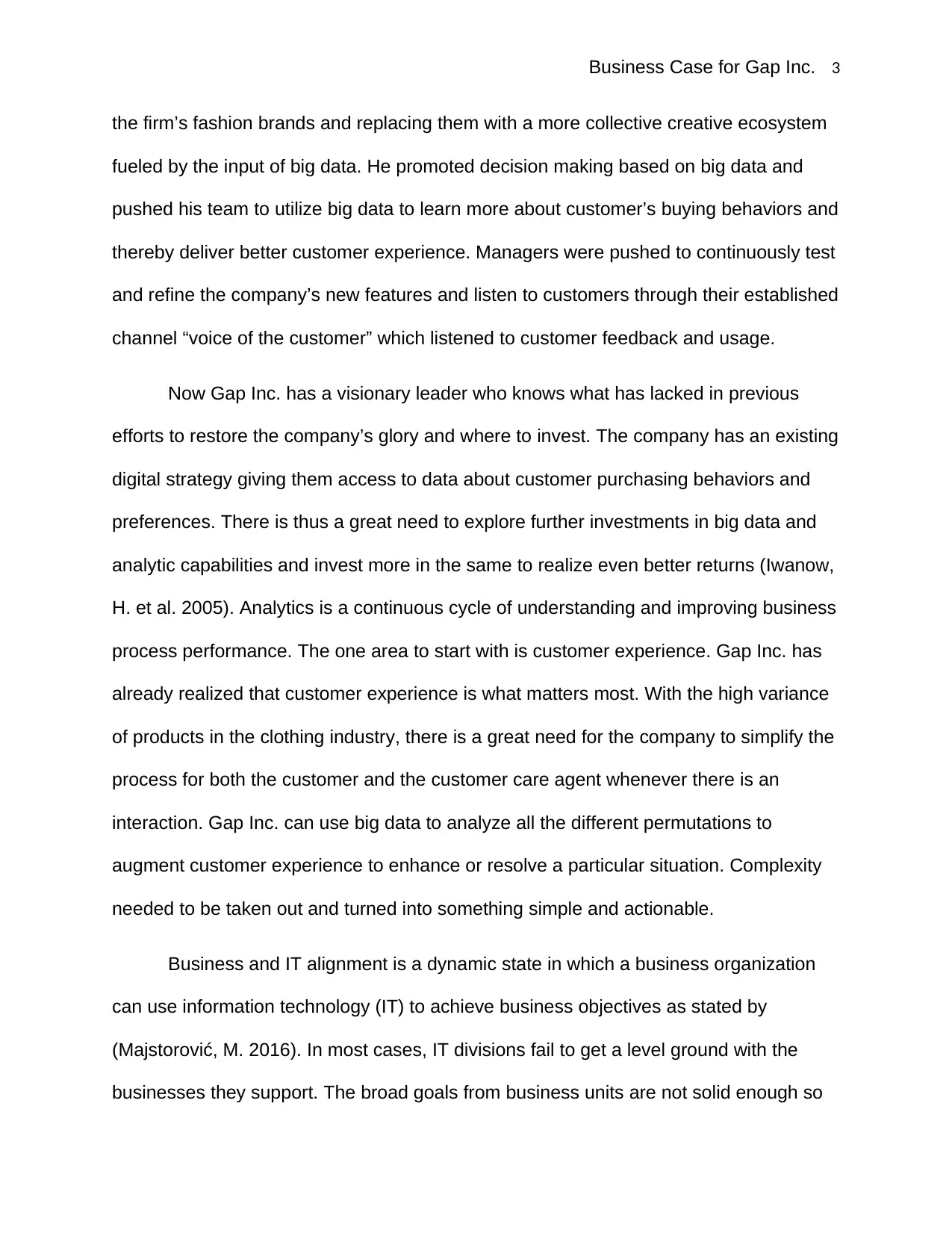
Business Case for Gap Inc. 3
the firm’s fashion brands and replacing them with a more collective creative ecosystem
fueled by the input of big data. He promoted decision making based on big data and
pushed his team to utilize big data to learn more about customer’s buying behaviors and
thereby deliver better customer experience. Managers were pushed to continuously test
and refine the company’s new features and listen to customers through their established
channel “voice of the customer” which listened to customer feedback and usage.
Now Gap Inc. has a visionary leader who knows what has lacked in previous
efforts to restore the company’s glory and where to invest. The company has an existing
digital strategy giving them access to data about customer purchasing behaviors and
preferences. There is thus a great need to explore further investments in big data and
analytic capabilities and invest more in the same to realize even better returns (Iwanow,
H. et al. 2005). Analytics is a continuous cycle of understanding and improving business
process performance. The one area to start with is customer experience. Gap Inc. has
already realized that customer experience is what matters most. With the high variance
of products in the clothing industry, there is a great need for the company to simplify the
process for both the customer and the customer care agent whenever there is an
interaction. Gap Inc. can use big data to analyze all the different permutations to
augment customer experience to enhance or resolve a particular situation. Complexity
needed to be taken out and turned into something simple and actionable.
Business and IT alignment is a dynamic state in which a business organization
can use information technology (IT) to achieve business objectives as stated by
(Majstorović, M. 2016). In most cases, IT divisions fail to get a level ground with the
businesses they support. The broad goals from business units are not solid enough so
the firm’s fashion brands and replacing them with a more collective creative ecosystem
fueled by the input of big data. He promoted decision making based on big data and
pushed his team to utilize big data to learn more about customer’s buying behaviors and
thereby deliver better customer experience. Managers were pushed to continuously test
and refine the company’s new features and listen to customers through their established
channel “voice of the customer” which listened to customer feedback and usage.
Now Gap Inc. has a visionary leader who knows what has lacked in previous
efforts to restore the company’s glory and where to invest. The company has an existing
digital strategy giving them access to data about customer purchasing behaviors and
preferences. There is thus a great need to explore further investments in big data and
analytic capabilities and invest more in the same to realize even better returns (Iwanow,
H. et al. 2005). Analytics is a continuous cycle of understanding and improving business
process performance. The one area to start with is customer experience. Gap Inc. has
already realized that customer experience is what matters most. With the high variance
of products in the clothing industry, there is a great need for the company to simplify the
process for both the customer and the customer care agent whenever there is an
interaction. Gap Inc. can use big data to analyze all the different permutations to
augment customer experience to enhance or resolve a particular situation. Complexity
needed to be taken out and turned into something simple and actionable.
Business and IT alignment is a dynamic state in which a business organization
can use information technology (IT) to achieve business objectives as stated by
(Majstorović, M. 2016). In most cases, IT divisions fail to get a level ground with the
businesses they support. The broad goals from business units are not solid enough so
⊘ This is a preview!⊘
Do you want full access?
Subscribe today to unlock all pages.

Trusted by 1+ million students worldwide
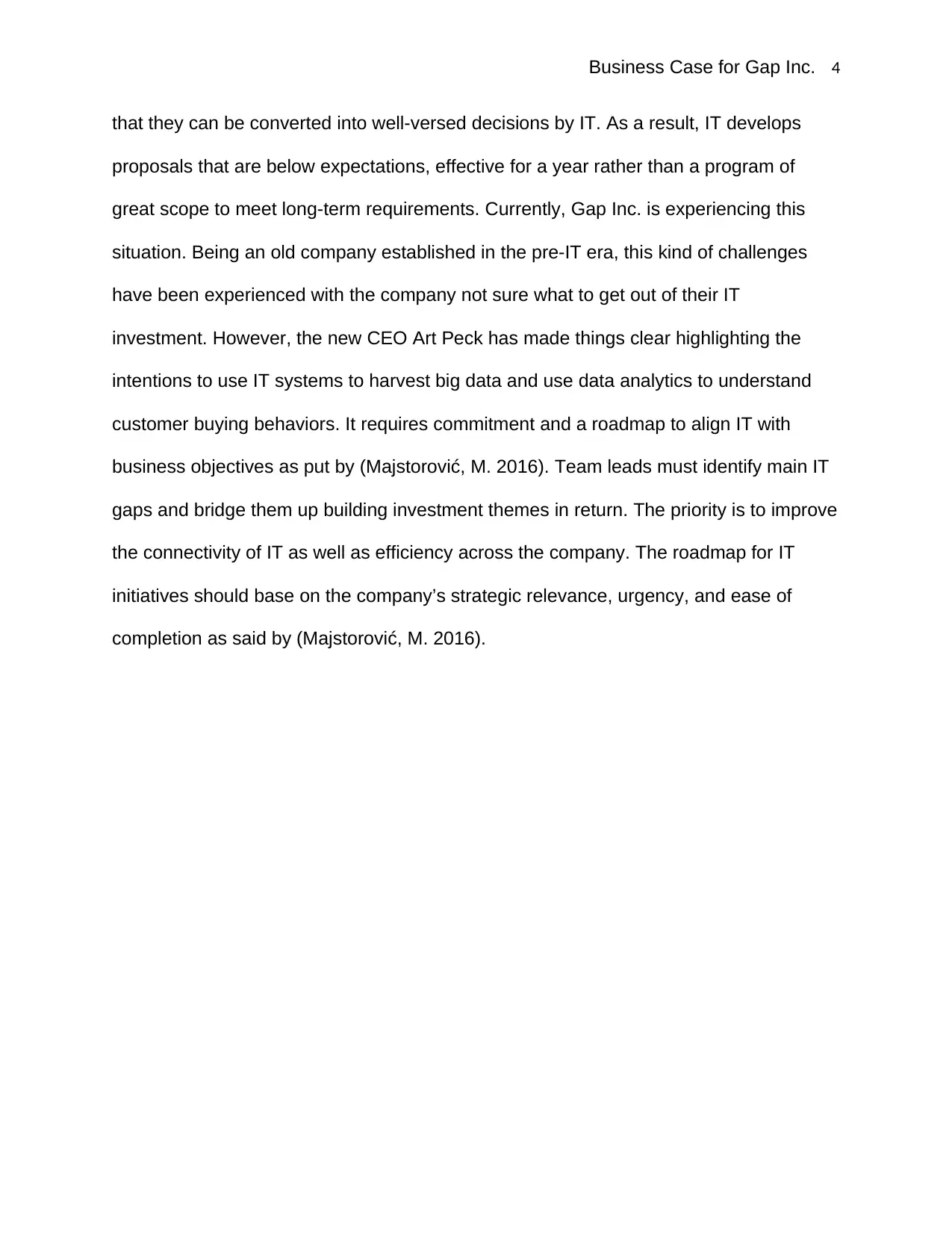
Business Case for Gap Inc. 4
that they can be converted into well-versed decisions by IT. As a result, IT develops
proposals that are below expectations, effective for a year rather than a program of
great scope to meet long-term requirements. Currently, Gap Inc. is experiencing this
situation. Being an old company established in the pre-IT era, this kind of challenges
have been experienced with the company not sure what to get out of their IT
investment. However, the new CEO Art Peck has made things clear highlighting the
intentions to use IT systems to harvest big data and use data analytics to understand
customer buying behaviors. It requires commitment and a roadmap to align IT with
business objectives as put by (Majstorović, M. 2016). Team leads must identify main IT
gaps and bridge them up building investment themes in return. The priority is to improve
the connectivity of IT as well as efficiency across the company. The roadmap for IT
initiatives should base on the company’s strategic relevance, urgency, and ease of
completion as said by (Majstorović, M. 2016).
that they can be converted into well-versed decisions by IT. As a result, IT develops
proposals that are below expectations, effective for a year rather than a program of
great scope to meet long-term requirements. Currently, Gap Inc. is experiencing this
situation. Being an old company established in the pre-IT era, this kind of challenges
have been experienced with the company not sure what to get out of their IT
investment. However, the new CEO Art Peck has made things clear highlighting the
intentions to use IT systems to harvest big data and use data analytics to understand
customer buying behaviors. It requires commitment and a roadmap to align IT with
business objectives as put by (Majstorović, M. 2016). Team leads must identify main IT
gaps and bridge them up building investment themes in return. The priority is to improve
the connectivity of IT as well as efficiency across the company. The roadmap for IT
initiatives should base on the company’s strategic relevance, urgency, and ease of
completion as said by (Majstorović, M. 2016).
Paraphrase This Document
Need a fresh take? Get an instant paraphrase of this document with our AI Paraphraser
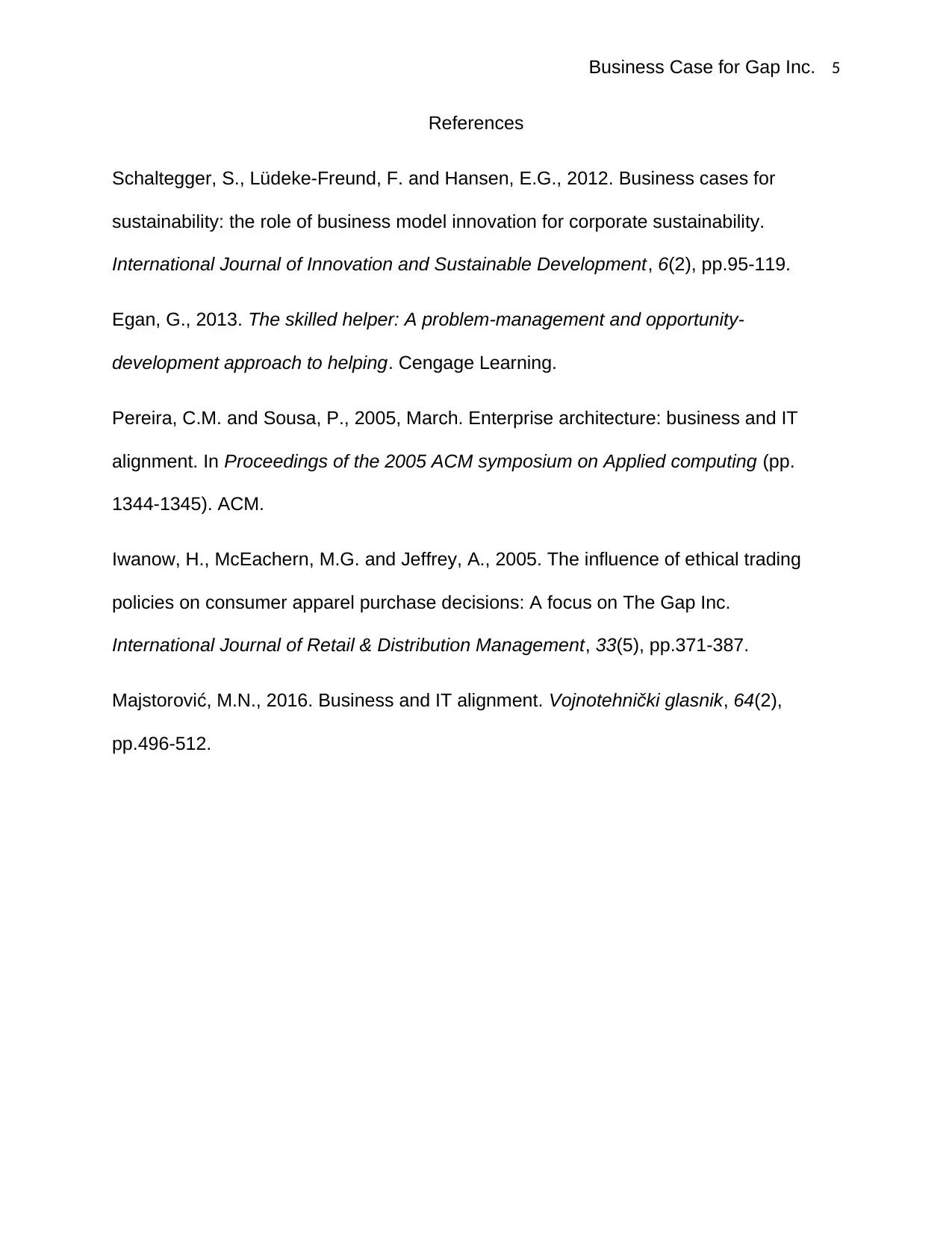
Business Case for Gap Inc. 5
References
Schaltegger, S., Lüdeke-Freund, F. and Hansen, E.G., 2012. Business cases for
sustainability: the role of business model innovation for corporate sustainability.
International Journal of Innovation and Sustainable Development, 6(2), pp.95-119.
Egan, G., 2013. The skilled helper: A problem-management and opportunity-
development approach to helping. Cengage Learning.
Pereira, C.M. and Sousa, P., 2005, March. Enterprise architecture: business and IT
alignment. In Proceedings of the 2005 ACM symposium on Applied computing (pp.
1344-1345). ACM.
Iwanow, H., McEachern, M.G. and Jeffrey, A., 2005. The influence of ethical trading
policies on consumer apparel purchase decisions: A focus on The Gap Inc.
International Journal of Retail & Distribution Management, 33(5), pp.371-387.
Majstorović, M.N., 2016. Business and IT alignment. Vojnotehnički glasnik, 64(2),
pp.496-512.
References
Schaltegger, S., Lüdeke-Freund, F. and Hansen, E.G., 2012. Business cases for
sustainability: the role of business model innovation for corporate sustainability.
International Journal of Innovation and Sustainable Development, 6(2), pp.95-119.
Egan, G., 2013. The skilled helper: A problem-management and opportunity-
development approach to helping. Cengage Learning.
Pereira, C.M. and Sousa, P., 2005, March. Enterprise architecture: business and IT
alignment. In Proceedings of the 2005 ACM symposium on Applied computing (pp.
1344-1345). ACM.
Iwanow, H., McEachern, M.G. and Jeffrey, A., 2005. The influence of ethical trading
policies on consumer apparel purchase decisions: A focus on The Gap Inc.
International Journal of Retail & Distribution Management, 33(5), pp.371-387.
Majstorović, M.N., 2016. Business and IT alignment. Vojnotehnički glasnik, 64(2),
pp.496-512.
1 out of 5
Your All-in-One AI-Powered Toolkit for Academic Success.
+13062052269
info@desklib.com
Available 24*7 on WhatsApp / Email
![[object Object]](/_next/static/media/star-bottom.7253800d.svg)
Unlock your academic potential
Copyright © 2020–2025 A2Z Services. All Rights Reserved. Developed and managed by ZUCOL.
